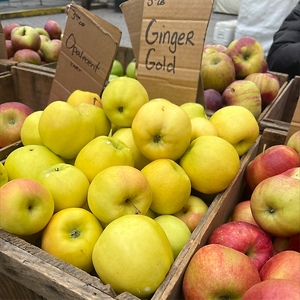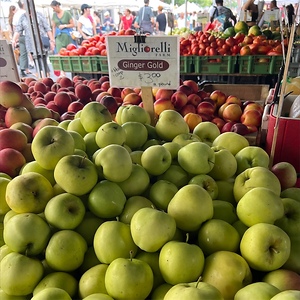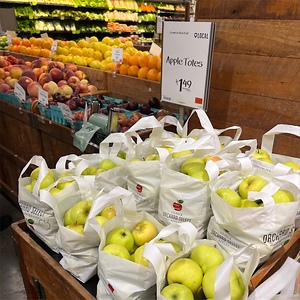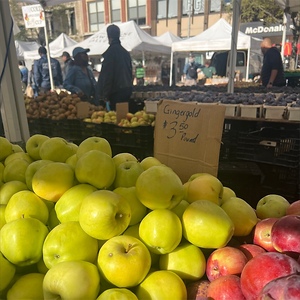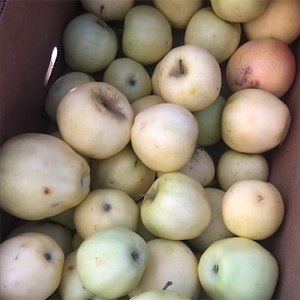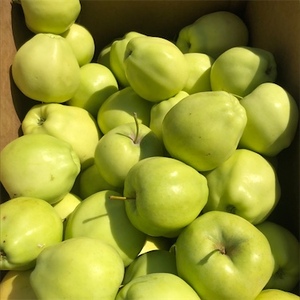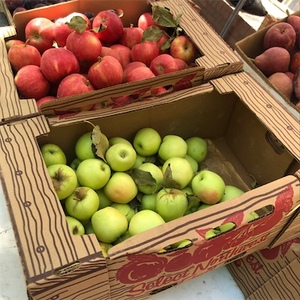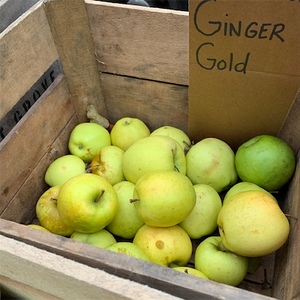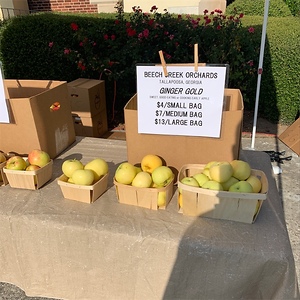

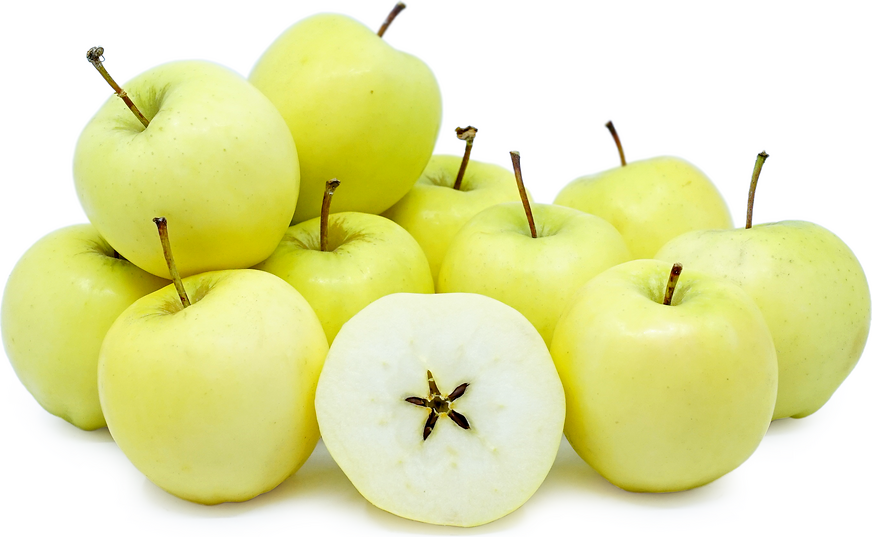
Ginger Gold Apples
Estimated Inventory, lb : 0
Description/Taste
Ginger Gold apples are generally small but can vary in size from small to medium, depending on their growing environment, and have a conical shape, tapering slightly towards the base. The apples have a characteristically long and slender brown stalk and sometimes showcase surface ribbing. The semi-thin skin ripens from green to pale yellow and has a small patch of rough brown russeting in the stem cavity. If the apples are left for extended periods on the tree, they will develop a waxy coating and the occasional light red blush. Underneath the surface, the white to cream-colored flesh has a fine-grained, aqueous, and crisp consistency. The flesh also oxidizes slowly, encasing a central core filled with tiny black-brown seeds. Ginger Gold apples are initially tart when harvested, developing a sweeter, milder flavor with spice-filled nuances with age.
Seasons/Availability
Ginger Gold apples are available in the late summer through fall.
Current Facts
Ginger Gold apples, botanically classified as Malus domestica, are an early-season variety belonging to the Rosaceae family. The pale-yellow apples are one of the first commercial apple varieties to arrive in American markets each year and were discovered as a chance seedling growing in an orchard in Virginia in the late 20th century. Ginger Gold apples are also a popular home garden variety as the fruits grow on compact, semi-dwarf trees that reach 3 to 4 meters in height. Unlike other early-season cultivars, Ginger Gold apples have good storage properties, allowing them to be kept for extended use. Ginger Gold apples have a sweet-tart flavor that can be consumed fresh or utilized in cooked preparations.
Nutritional Value
Ginger Gold apples are a source of fiber to regulate the digestive tract, copper to build connective tissues, vitamin C to strengthen the immune system, and potassium to balance fluid levels within the body. The apples also provide vitamin K to assist in faster wound healing, folate to develop healthy red blood cells, manganese to promote calcium absorption, phosphorus to build strong bones and teeth, and other amounts of magnesium and calcium.
Applications
Ginger Gold apples have a sweet-tart flavor suited for fresh and cooked preparations. The apples can be consumed straight out of hand and will have varying levels of tartness, depending on when they are harvested off the tree. The apples can also be chopped into salads and slaws, stirred into fruit bowls, or mixed into overnight oats. Ginger Gold apples have a crisp consistency when freshly harvested, allowing them to be used as a crunchy element in sandwiches, burgers, and grilled cheeses. In addition to fresh preparations, Ginger Gold apples hold their shape well when cooked. The apples can be used in baked goods such as pies, tarts, turnovers, muffins, bread, and cobblers, or baked whole, stuffed with spices and nuts. They can also be sauteed in browned butter and spices, pureed into apple sauce, or simmered into jams, jellies, and preserves. Beyond fresh preparations, Ginger Gold apples can be dried for extended use, consumed as a chewy snack, stirred into trail mix, or added to desserts. Ginger Gold apples pair well with cheeses such as parmesan, cheddar, and feta, spices including cinnamon, cloves, and nutmeg, and herbs such as parsley, basil, and mint. Whole, unwashed Ginger Gold apples will keep for several weeks when stored in the refrigerator’s crisper drawer.
Ethnic/Cultural Info
Ginger Gold apples were named after apple grower Frances “Ginger” Harvey. Frances and her husband Clyde owned an apple orchard in Nelson County, Virginia. In 1969 Hurricane Camille swept through Nelson County and caused massive floods, destroying most of the town. After the hurricane, Frances and Clyde returned to their orchard to assess the damage and discovered that most of their trees had been destroyed. The Harvey’s recovered what they could and gathered a small chance seedling that had survived on one of the edges of their orchard. The seedling was planted, and when it fruited, it produced unusual yellow-green fruits. The Harvey’s propagated the new variety, believing the apple arose from Golden Delicious parentage and named the apple after Frances, who often went by the nickname “Ginger.” Ginger Gold apples are also known as the “apples brought by Hurricane Camille,” a name given in honor of the apple’s whirlwind origins.
Geography/History
Ginger Gold apples were discovered as a chance seedling in Clyde and Frances Harvey’s orchard near the Blue Ridge Mountains in Nelson County, Virginia. The variety was found in the mid to late 20th century and was selected for cultivation, initially offering the apples locally through grocers and farmers markets. Over time, the apple variety spread across the United States and became a favored early-season cultivar. Ginger Gold apples are believed to have been created from a natural cross-pollination of a Golden Delicious apple with another unknown variety, possibly an Albermarle Pippin. Today Ginger Gold apples are a commercially produced variety, especially in New England and mid-Atlantic growing regions, and are offered through distributors, select grocers, farmers markets, and direct from growers at roadside stands. The apples are also planted in home gardens as a versatile early-season apple.
Recipe Ideas
Recipes that include Ginger Gold Apples. One
| Food Babbles |
|
Ginger Apple Upside Down Squares |
| Fine Cooking |
|
Brown Rice Salad with Apples and Cheddar |



